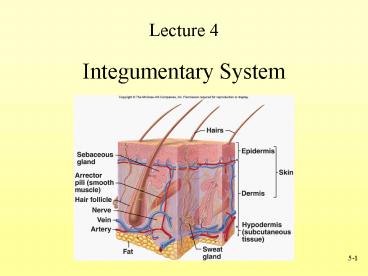Integumentary System - PowerPoint PPT Presentation
1 / 14
Title:
Integumentary System
Description:
Melanocytes: Contribute to skin color (pigment melanin) ... Nail body distally: Eponychium or cuticle. Growth. Grow continuously unlike hair. Fig. 5.8 ... – PowerPoint PPT presentation
Number of Views:54
Avg rating:3.0/5.0
Title: Integumentary System
1
Lecture 4
- Integumentary System
2
Integumentary System
- Consists of
- Skin (Epidermis Dermis)
- Accessory structures
- Hair
- Nails
- Glands
- Functions
- Protection
- Sensation
- Temperature regulation
- Vitamin D production
- Excretion
Fig. 5.1
3
Epidermis and Dermis
Fig. 5.2
4
Epidermal Cells
- Cell types
- Keratinocytes Produce keratin for strength
- Melanocytes Contribute to skin color (pigment
melanin) - Langerhans cells Part of the immune system
- Merkels cells Detect light touch and pressure
- Desquamate Older cells slough off
- Keratinization Cells die and produce outer layer
that resists abrasion and forms permeability layer
5
Epidermal Strata
- Stratum Basale
- Deepest portion of epidermis and single layer
- High mitotic activity and cells become
keratinized - Stratum Spinosum
- Limited cell division
- Stratum Granulosum
- In superficial layers nucleus and other
organelles degenerate and cell dies - Stratum Lucidum
- Thin, clear zone
- Stratum Corneum
- Most superficial and consists of cornified cells
6
Epidermal Layers and Keratinization
Fig. 5.4
7
Dermis
- Structural strength
- Two layers
- Deeper layer - dense connective tissue stretch
marks (striae) - Superficial layer underneath epidermis - loose
connective tissue
Fig. 5.1
8
Hypodermis
- Skin rests on this, but not a part
- Also called
- Subcutaneous tissue
- Superficial fascia
- Consists of loose connective tissue
- Types of cells
- Fibroblasts
- Adipose (fat) cells
- Macrophages
- Subcutaneous fat
9
Accessory Skin Structures
- Hair
- Found everywhere on human body except palms,
soles, lips, nipples, parts of external
genitalia, and distal segments of fingers and
toes - Glands
- Sebaceous or oil glands
- Sudoriferous or sweat glands
- Mammary glands
- Nails
10
Hair (Pilus) Structure
- Composed of shaft and root
- Shaft protrudes above skin surface
- Root located below surface and base forms the
hair bulb - Has 3 concentric layers
- Medulla Central axis
- Cortex Forms bulk of hair
- Cuticle Forms hair surface
Fig. 5.6a
11
Nails
- Anatomy
- Nail root proximally
- Nail body distally Eponychium or cuticle
- Growth
- Grow continuously unlike hair
Fig. 5.8
12
Oil and Sweat Glands
- Sebaceous glands
- Produce sebum
- Oils hair and skin surface
- Sudoriferous glands (sweat)
- Most commonly found in palms, soles and forehead
- Also found in axillae (arm pit), genitalia,
around anus - Ceruminous glands (cerumen or ear wax)
- Mammary glands
Fig. 5.7
13
Points to Remember
- Two components to integumentary system
- Skin (epidermis dermis)
- Accessory structures (hair, nails and glands)
- Keratinization (accumulation of keratin) produces
upper layer of cells of epidermis, hair and nails - Two types of glands in skin
- Sebaceous (oily)
- Sudiferous (watery)
14
Questions?































